Analysis of Spatial and Temporal Changes and Drivers of Urban Sprawl in Xinjiang Based on Integrated DMSP-OLS and NPP-VIIRS Data
Abstract
1. Introduction
2. Data and Materials
2.1. Study Area
2.2. Data Sources
2.3. Research Method
2.3.1. Urban Extraction of Xinjiang Based on the Best Threshold Method
2.3.2. Urban Expansion Scale and Form Indicators
TDN
Standard Deviation Ellipse Method
Center-of-Gravity Migration Distance
2.3.3. Analysis of Urbanization Indicators and Meteorological Data
Urbanization Rate
Urban Expansion Dynamic Change Rate
5a for the Sliding Average Algorithm
Mann–Kendall Trend Test
2.3.4. Analysis of the Driving Force of Urban Expansion Dynamic Change Rate
2.4. Research Framework
3. Results and Analysis
3.1. Monitoring the Total NTL Value in Xinjiang
3.1.1. Interannual Variations in Total NTL Values in Xinjiang Cities
3.1.2. Spatial Changes in NTL in Xinjiang Cities
Standard Deviation Ellipses and Changes in the Center of Gravity of Light at Night
Spatial and Temporal Variations in NTL in Major Cities
3.2. Analysis of the Driving Factors of Urban Expansion in Xinjiang
3.2.1. Characteristics and Influence of Temperature Factors in Xinjiang
Temperature Factor Changes in Xinjiang
Spatial Variation in Temperature Elements in Xinjiang
Urbanization Rate and Temperature Change
3.2.2. Characteristics and Influence of Precipitation Factors in Xinjiang
Change Characteristics of Precipitation
Spatial Variation Characteristics of Precipitation Elements
Urbanization Rates and Changes in Precipitation
3.2.3. Analysis of the Driving Force of Urban Expansion Dynamic Change Rate
Factor Detection
Interactive Detection
4. Discussion
4.1. Advantages and Limitations of NTL in Urban Extraction Studies
4.2. Characteristics of Urban Development in Xinjiang
4.3. Relationship between Urban Development and Climate
5. Conclusions and Outlook
5.1. Conclusions
- (1)
- Changes in the total nighttime light value: The total nighttime light value of cities in Xinjiang has been increasing year by year, with significant growth rates during the periods of 1992–1997 and 2007–2017. Influenced by the development of cities in southern Xinjiang such as Kashgar City and Korla City, as well as the rapid development of areas in the east like Yining City, the regional center of gravity in Xinjiang has noticeably shifted towards the southwest direction from 2012 to 2022.
- (2)
- Relationship between climate factors and urban development: From 1992 to 2022, the 5-year moving average of annual temperature and annual precipitation in Xinjiang showed an upward trend, with growth rates of 0.036 °C per year and 0.57 mm per year, respectively. With the increase in temperature and precipitation, the urbanization rate in Xinjiang exhibited an upward trend after experiencing fluctuations.
- (3)
- Analysis of influencing factors on urban expansion dynamics: Through the geographic detector model, it was found that both socioeconomic factors and natural environmental factors jointly influence the dynamic changes in urban expansion. In the single-factor detection, precipitation is the main influencing factor, followed by temperature and GDP, with the least impact from slope. In the interaction factor detection, the interactive effect between precipitation and GDP has the greatest influence.
5.2. Outlook
Author Contributions
Funding
Data Availability Statement
Conflicts of Interest
References
- Li, L.; Zhan, W.; Hu, L.; Chakraborty, T.; Wang, Z.; Fu, P.; Wang, D.; Liao, W.; Huang, F.; Fu, H.; et al. Divergent urbanization-induced impacts on global surface urban heat island trends since 1980s. Remote Sens. Environ. 2023, 295, 113650. [Google Scholar] [CrossRef]
- Das, M.; Das, A. Dynamics of Urbanization and Its Impact on Urban Ecosystem Services (UESs): A study of a medium-size town in West Bengal, Eastern India. J. Urban Manag. 2019, 8, 420–434. [Google Scholar] [CrossRef]
- Zhang, M.; Du, H.; Zhou, G.; Mao, F.; Li, X.; Zhou, L.; Zhu, D.; Xu, Y.; Huang, Z. Spatiotemporal Patterns and Driving Force of Urbanization and Its Impact on Urban Ecology. Remote Sens. 2022, 14, 1160. [Google Scholar] [CrossRef]
- Li, L.; Zhao, K.; Wang, X.; Zhao, S.; Liu, X.; Li, W. Spatio-temporal evolution and driving mechanism of urbanization in small cities: Case study from Guangxi. Land 2022, 11, 415. [Google Scholar] [CrossRef]
- Fu, S.; Zhang, X.; Kuang, W.; Guo, C. Characteristics of Changes in Urban Land Use and Efficiency Evaluation in the Qinghai-Tibet Plateau from 1990 to 2020. Land 2022, 11, 757. [Google Scholar] [CrossRef]
- Mokhtari, Z.; Amani-Beni, M.; Asgarian, A.; Russo, A.; Qureshi, S.; Karami, A. Spatial prediction of the urban inter-annual land surface temperature variability: An integrated modeling approach in a rapidly urbanizing semi-arid region. Sustain. Cities Soc. 2023, 93, 104523. [Google Scholar] [CrossRef]
- Chu, M.; Lu, J.; Sun, D. Influence of urban agglomeration expansion on fragmentation of green space: A case study of Beijing-Tianjin-Hebei urban agglomeration. Land 2022, 11, 275. [Google Scholar] [CrossRef]
- Vasenev, V.; Stoorvogel, J.; Leemans, R.; Valentini, R.; Hajiaghayeva, R. Projection of urban expansion and related changes in soil carbon stocks in the Moscow Region. J. Clean. Prod. 2018, 170, 902–914. [Google Scholar] [CrossRef]
- Zari, M.P.; MacKinnon, M.; Varshney, K.; Bakshi, N. Regenerative living cities and the urban climate-biodiversity-wellbeing nexus. Nat. Clim. Chang. 2022, 12, 601–604. [Google Scholar] [CrossRef]
- Hao, L.; Chen, X.; Min, C. The impact of urban sprawl and smart city construction on regional coordination. Sci. Program. 2021, 2021, 5589571. [Google Scholar] [CrossRef]
- Krayenhoff, E.S.; Moustaoui, M.; Broadbent, A.M.; Gupta, V.; Georgescu, M. Diurnal interaction between urban expansion, climate change and adaptation in US cities. Nat. Clim. Chang. 2018, 8, 1097–1103. [Google Scholar] [CrossRef]
- Ozturk, U.; Bozzolan, E.; Holcombe, E.A.; Shukla, R.; Pianosi, F.; Wagener, T. How climate change and unplanned urban sprawl bring more landslides. Nature 2022, 608, 262–265. [Google Scholar] [CrossRef]
- Ren, Q.; He, C.; Huang, Q.; Shi, P.; Zhang, D.; Güneralp, B. Impacts of urban expansion on natural habitats in global dry lands. Nat. Sustain. 2022, 5, 869–878. [Google Scholar] [CrossRef]
- Van, V.J. Direct and indirect loss of natural area from urban expansion. Nat. Sustain. 2019, 2, 755–763. [Google Scholar] [CrossRef]
- Wang, X.; Jiang, D.; Lang, X. Future extreme climate changes linked to global warming intensity. Sci. Bull. 2017, 62, 1673–1680. [Google Scholar] [CrossRef]
- Fowler, H.J.; Blenkinsop, S.; Green, A.; Davies, P.A. Precipitation extremes in 2023. Nat. Rev. Earth Environ. 2024, 5, 250–252. [Google Scholar] [CrossRef]
- Yin, Y.Y.; Wang, G.X. Global Climate Change Assessment Methods and Their Applications; Higher Education Press: Beijing, China, 2004. (In Chinese) [Google Scholar]
- Bastos, A.; Ciais, P.; Friedlingstein, P.; Sitch, S.; Pongratz, J.; Fan, L.; Wigneron, J.P.; Weber, U.; Reichstein, M.; Fu, Z.; et al. Direct and seasonal legacy effects of the 2018 heat wave and drought on European ecosystem productivity. Sci. Adv. 2020, 6, eaba2724. [Google Scholar] [CrossRef]
- Kogo, B.K.; Kumar, L.; Koech, R. Climate change and variability in Kenya: A review of impacts on agriculture and food security. Environ. Dev. Sustain. 2020, 23, 23–43. [Google Scholar] [CrossRef]
- Ghaffar, A.; Rahman, M.H.U.; Ahmed, S.; Haider, G.; Ahmad, I.; Khan, M.A.; Afzaal, M.; Ahmed, S.; Fahad, S.; Hussain, J.; et al. Adaptations in Cropping System and Pattern for Sustainable Crops Production under Climate Change Scenarios; CRC Press: Boca Raton, FL, USA, 2022; Volume 10. [Google Scholar] [CrossRef]
- Li, X.; Long, D.; Scanlon, B.R.; Mann, M.E.; Li, X.; Tian, F.; Sun, Z.; Wang, G. Climate change threatens terrestrial water storage over the Tibetan Plateau. Nat. Clim. Chang. 2022, 12, 801–807. [Google Scholar] [CrossRef]
- Lupi, V.; Marsiglio, S. Population growth and climate change: A dynamic integrated climate-economy-demography model. Ecol. Econ. 2021, 184, 107011. [Google Scholar] [CrossRef]
- Ge, S.; Zhan, W.; Wang, S.; Du, H.; Liu, Z.; Wang, C.; Wang, C.; Jiang, S.; Dong, P. Spatiotemporal heterogeneity in global urban surface warming. Remote Sens. Environ. 2024, 305, 114081. [Google Scholar] [CrossRef]
- Shen, P.; Zhao, S.; Ma, Y.; Liu, S. Urbanization-induced Earth’s surface energy alteration and warming: A global spatiotemporal analysis. Remote Sens. Environ. 2023, 284, 113361. [Google Scholar] [CrossRef]
- Wenqian, J.; Guoyu, R.; Fengjun, J.; Jiajun, H.; Panfeng, Z. Spatial-temporal characteristics of the urban heat island effect in Xiamen, China. Urban Clim. 2023, 52, 101725. [Google Scholar] [CrossRef]
- Mathew, A.; Khandelwal, S.; Kaul, N. Analysis of diurnal surface temperature variations for the assessment of surface urban heat island effect over Indian cities. Energy Build. 2018, 159, 271–295. [Google Scholar] [CrossRef]
- Yuan, S.; Ren, Z.; Shan, X.; Deng, Q.; Zhou, Z. Seasonal different effects of land cover on urban heat island in Wuhan’s metropolitan area. Urban Clim. 2023, 49, 101547. [Google Scholar] [CrossRef]
- Liang, P.; Ding, Y. The long-term variation of extreme heavy precipitation and its link to urbanization effects in Shanghai during 1916–2014. Adv. Atmos. Sci. 2017, 34, 321–334. [Google Scholar] [CrossRef]
- Kong, F.; Wang, Y.F.; Fang, J. Spatial Pattern of Extreme Precipitation in China during Summer and Its Response to Urbanization (1961–2010). Resour. Environ. Yangtze Basin 2018, 27, 996–1010. (In Chinese) [Google Scholar]
- Hu, S.; Huang, S.; Hu, Q.; Wang, S.; Chen, Q. An commercial area extraction approach using time series nighttime light remote sensing data—Take Wuhan City as a case. Sustain. Cities Soc. 2023, 100, 105032. [Google Scholar] [CrossRef]
- Stokes, E.C.; Roman, M.O.; Wang, Z.; Kyba, C.C.M.; Miller, S.D.; Storch, T.; Gurney, K.R. Retired satellites: A chance to shed light. Science 2021, 373, 1451–1452. [Google Scholar] [CrossRef]
- Wang, J.; Qiu, S.; Du, J.; Meng, S.; Wang, C.; Teng, F.; Liu, Y. Spatial and temporal changes of urban built-up area in the Yellow River Basin from nighttime light data. Land 2022, 11, 1067. [Google Scholar] [CrossRef]
- Li, Y.; Song, Z.; Wu, B.; Yu, B.; Wu, Q.; Hong, Y.; Liu, S.; Wu, J. Evaluating the Ability of NOAA-20 Monthly Composite Data for Socioeconomic Indicators Estimation and Urban Area Extraction. IEEE J. Sel. Top. Appl. Earth Obs. Remote Sens. 2022, 15, 1837–1845. [Google Scholar] [CrossRef]
- Wu, B.; Yu, B.; Yao, S.; Wu, Q.; Chen, Z.; Wu, J. A surface network-based method for studying urban hierarchies by night-time light remote sensing data. Int. J. Geogr. Inf. Sci. 2019, 33, 1377–1398. [Google Scholar] [CrossRef]
- Ustaoglu, E.; Bovkır, R.; Aydınoglu, A.C. Spatial distribution of GDP based on integrated NPS-VIIRS nighttime light and MODIS EVI data: A case study of Turkey. Environ. Dev. Sustain. 2021, 23, 10309–10343. [Google Scholar] [CrossRef]
- Avtar, R.; Tripathi, S.; Aggarwal, A.K. Assessment of energy-population-urbanization nexus with changing energy industry scenario in India. Land 2019, 8, 124. [Google Scholar] [CrossRef]
- Sahoo, S.; Gupta, P.K.; Srivastav, S.K. Comparative analysis between VIIRS-DNB and DMSP-OLS night-time light data to estimate electric power consumption in Uttar Pradesh, India. Int. J. Remote Sens. 2020, 41, 2565–2580. [Google Scholar] [CrossRef]
- Zhang, S.; Wang, Y.; Xu, W.; Sheng, Z.; Zhu, Z.; Hou, Y. Analysis of Spatial and Temporal Variability of Ecosystem Service Values and Their Spatial Correlation in Xinjiang, China. Remote Sens. 2023, 15, 4861. [Google Scholar] [CrossRef]
- Kang, L.; Xia, S. Study on Urbanization Sustainability of Xinjiang in China: Connotation, Indicators and Measurement. Int. J. Environ. Res. Public Health 2023, 20, 2535. [Google Scholar] [CrossRef]
- Dong, H.; Li, R.; Li, J.; Li, S. Study on urban spatiotemporal expansion pattern of three first-class urban agglomerations in China derived from integrated DMSP-OLS and NPP-VIIRS nighttime light data. J. Geo-Inf. Sci. 2020, 22, 1161–1174. (In Chinese) [Google Scholar]
- Zhang, B.F.; Miao, C.H.; Song, Y.N.; Wang, J.J. Correction of DMSP/OLS stable night light images in China. J. Geo-Inf. Sci. 2020, 22, 1679–1691. (In Chinese) [Google Scholar]
- Li, D.R.; Yu, H.R.; Li, X. The Spatial-Temporal Pattern Analysis of City Development in Countries along the Belt and Road Initiative Based on Nighttime Light Data. Geomat. Inf. Sci. Wuhan Univ 2017, 42, 711–720. (In Chinese) [Google Scholar]
- Zhang, H.T. Research on the Coordinated Development of Xinjiang Military Based on the Three Spaces; Xinjiang University: Urumqi, China, 2022. (In Chinese) [Google Scholar]
- Yang, S.Q.; Wang, J.; Dou, Y.Y.; Luan, Q.; Kuang, W. Spatio-temporal evolution of urbanization and its relationship with regional climate change in Beijing over the past century. Acta Geogr. Sin. 2023, 78, 620–639. (In Chinese) [Google Scholar]
- Zhao, Z.Q.; Luo, H. Analysis of the Evolution of Urban Expansion Patterns in Kunming City Based on Nighttime Light Data. Surv. Spat. Geoinf. 2024, 47, 81–84+88. (In Chinese) [Google Scholar]
- Miao, Q.L.; Ding, Y.Y.; Wang, Y. Impact of climate warming on the distribution of China’s thermal resources. J. Nat. Resour. 2009, 24, 934–944. (In Chinese) [Google Scholar]
- Shi, H.Y.; Wang, G.Q. Impacts of climate change and hydraulic structures on runoff and sediment discharge in the middle Yellow River. Hydrol. Process. 2015, 29, 3236–3246. [Google Scholar] [CrossRef]
- Sen, P.K. Estimates of the regression coefficient based on Kendall’s tau. J. Am. Stat. Assoc. 1968, 63, 1379–1389. [Google Scholar] [CrossRef]
- Zhai, J.; Shao, Q.Q.; Liu, J.Y. Impact analysis of climate change from land use/cover change in Inner Mongolia Plateau. J. Nat. Resour. 2014, 29, 967–978. (In Chinese) [Google Scholar]
- Hu, D.; Meng, Q.; Zhang, L.; Zhang, Y. Spatial quantitative analysis of the potential driving factors of land surface temperature in different “Centers” of polycentric cities: A case study in Tianjin, China. Sci. Total Environ. 2020, 706, 135244. [Google Scholar] [CrossRef] [PubMed]
- Feng, R.; Wang, F.; Wang, K.; Wang, H.; Li, L. Urban ecological land and natural-anthropogenic environment interactively drive surface urban heat island: An urban agglomeration-level study in China. Environ. Int. 2021, 157, 106857. [Google Scholar] [CrossRef]
- Wang, J.F.; Xu, C.D. Geodetector: Principle and prospective. Acta Geogr. Sin. 2017, 72, 116–134. (In Chinese) [Google Scholar]
- Cao, A.L.; Zhang, H.; Zhang, Y.; Ma, W.C. Decadal changes of air temperature in Shanghai in recent 50 years and its relation to urbanization. Chin. J. Geophys. 2008, 51, 1663–1669. (In Chinese) [Google Scholar]
- Fu, H.; Shao, Z.; Fu, P.; Cheng, Q. The Dynamic Analysis between Urban Nighttime Economy and Urbanization Using the DMSP/OLS Nighttime Light Data in China from 1992 to 2012. Remote Sens. 2017, 9, 416. [Google Scholar] [CrossRef]
- Zou, Y.; Peng, H.; Liu, G.; Yang, K.; Xie, Y.; Weng, Q. Monitoring urban clusters expansion in the middle reaches of the Yangtze River, China, using time-series nighttime light images. Remote Sens. 2017, 9, 1007. [Google Scholar] [CrossRef]
- Ghosh, S.; Das, A. Exploring the lateral expansion dynamics of four metropolitan cities of India using DMSP-OLS night-time image. Spat. Inf. Res. 2017, 25, 779–789. [Google Scholar] [CrossRef]
- Fang, C.L. In the past 40 years of reform and opening up, China’s urbanization and urban agglomerations have made important progress and prospects. Econ. Geogr. 2018, 38, 1–9. (In Chinese) [Google Scholar]
- Otto, F.E. Attribution of Extreme Events to Climate Change. Annu. Rev. Environ. Resour. 2023, 48, 813–828. [Google Scholar] [CrossRef]
- Ebi, K.L.; Capon, A.; Berry, P.; Broderick, C.; de Dear, R.; Havenith, G.; Honda, Y.; Kovats, R.S.; Ma, W.; Malik, A.; et al. Hot weather and heat extremes: Health risks. Lancet 2021, 398, 698–708. [Google Scholar] [CrossRef] [PubMed]
- Burillo, D.; Chester, M.V.; Pincetl, S.; Fournier, E. Electricity infrastructure vulnerabilities due to long-term growth and extreme heat from climate change in Los Angeles County. Energy Policy 2019, 128, 943–953. [Google Scholar] [CrossRef]
- Knapp, A.K.; Beier, C.; Briske, D.D.; Classen, A.T.; Luo, Y.; Reichstein, M.; Smith, M.D.; Smith, S.D.; Bell, J.E.; Fay, P.A.; et al. Consequences of more extreme precipitation regimes for terrestrial ecosystems. Bioscience 2008, 58, 811–821. [Google Scholar] [CrossRef]
- Brelsford, C.; Lobo, J.; Hand, J.; Bettencourt, L.M.A. Heterogeneity and scale of sustainable development in cities. Proc. Natl. Acad. Sci. USA 2017, 114, 8963–8968. [Google Scholar] [CrossRef]
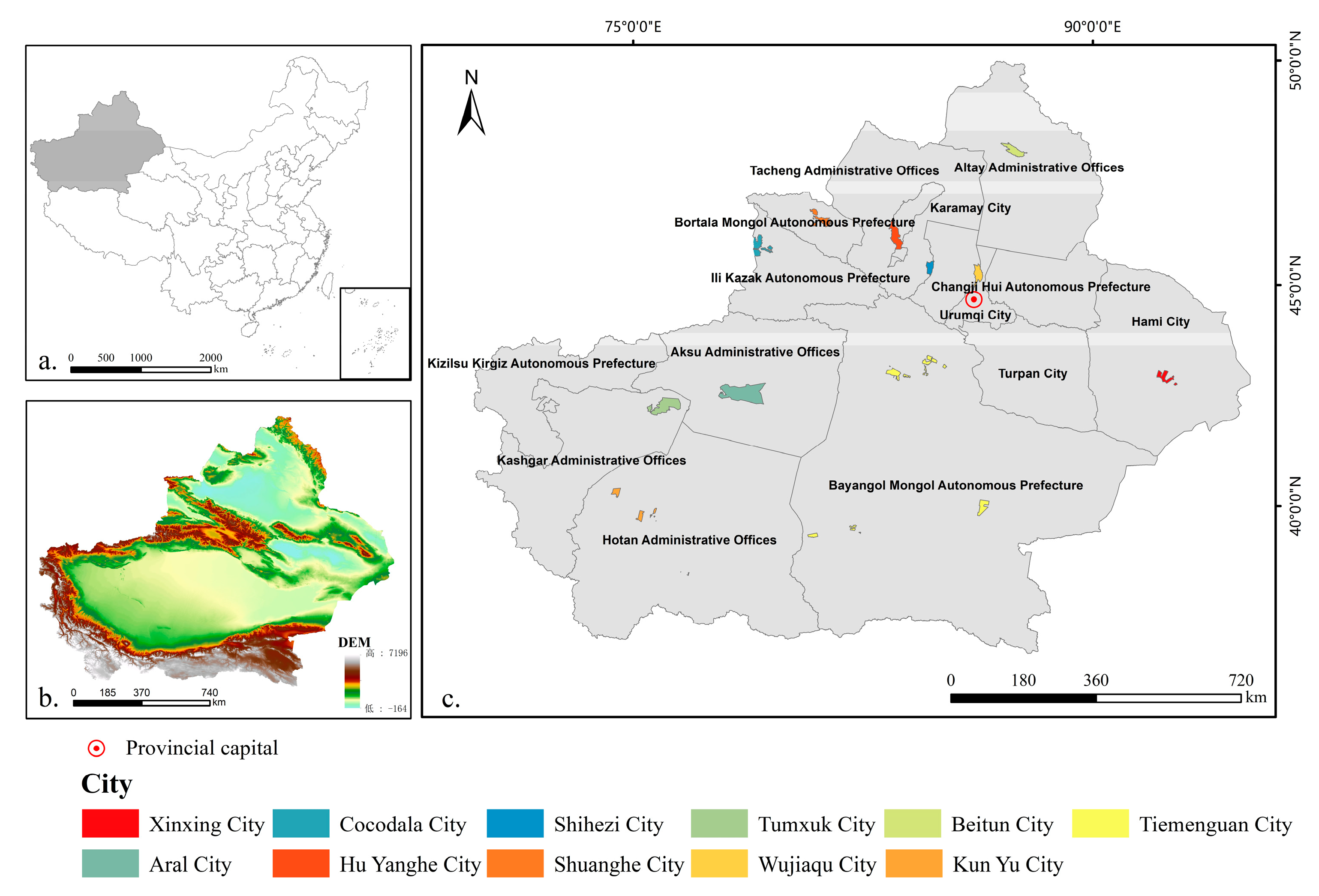


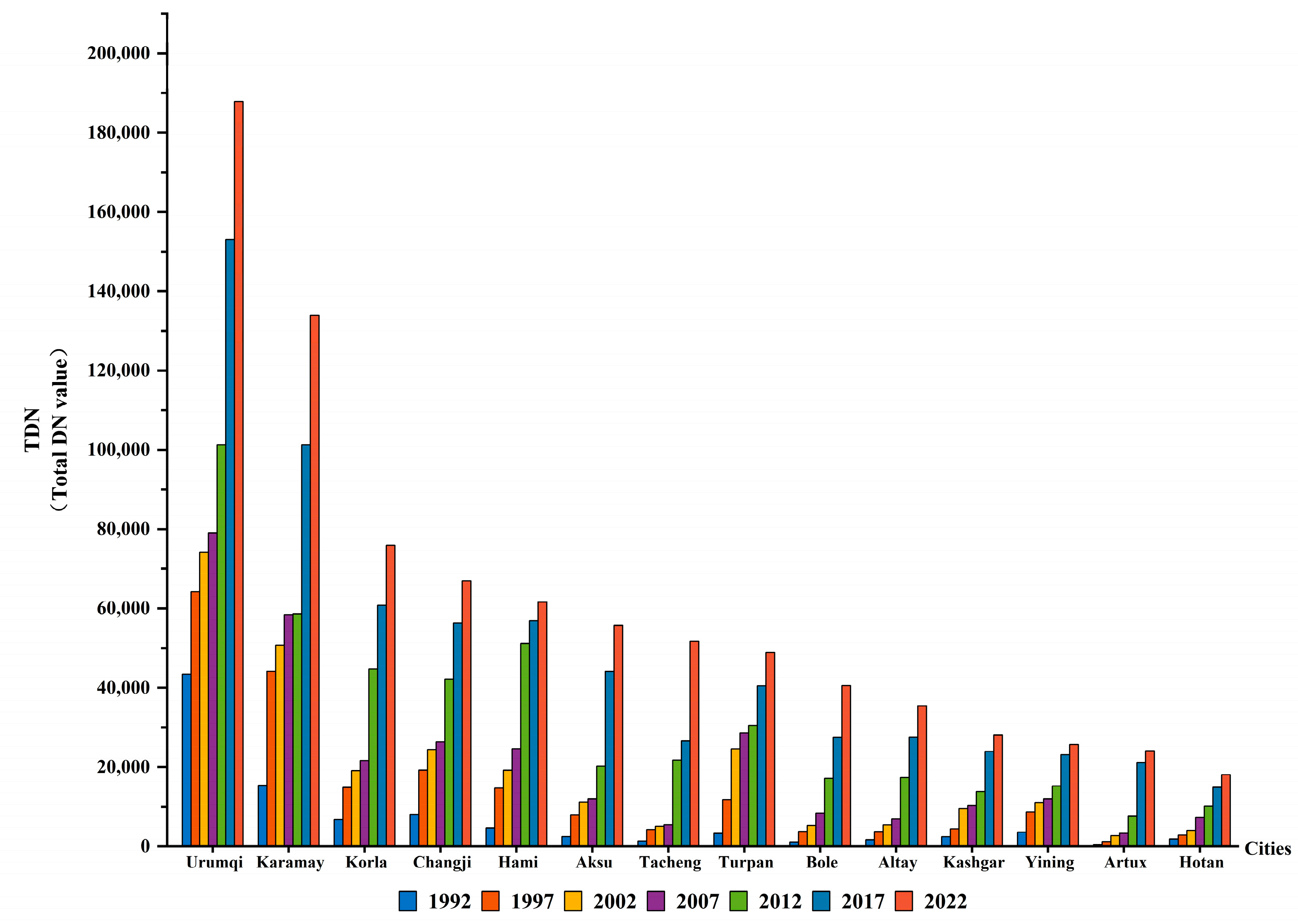
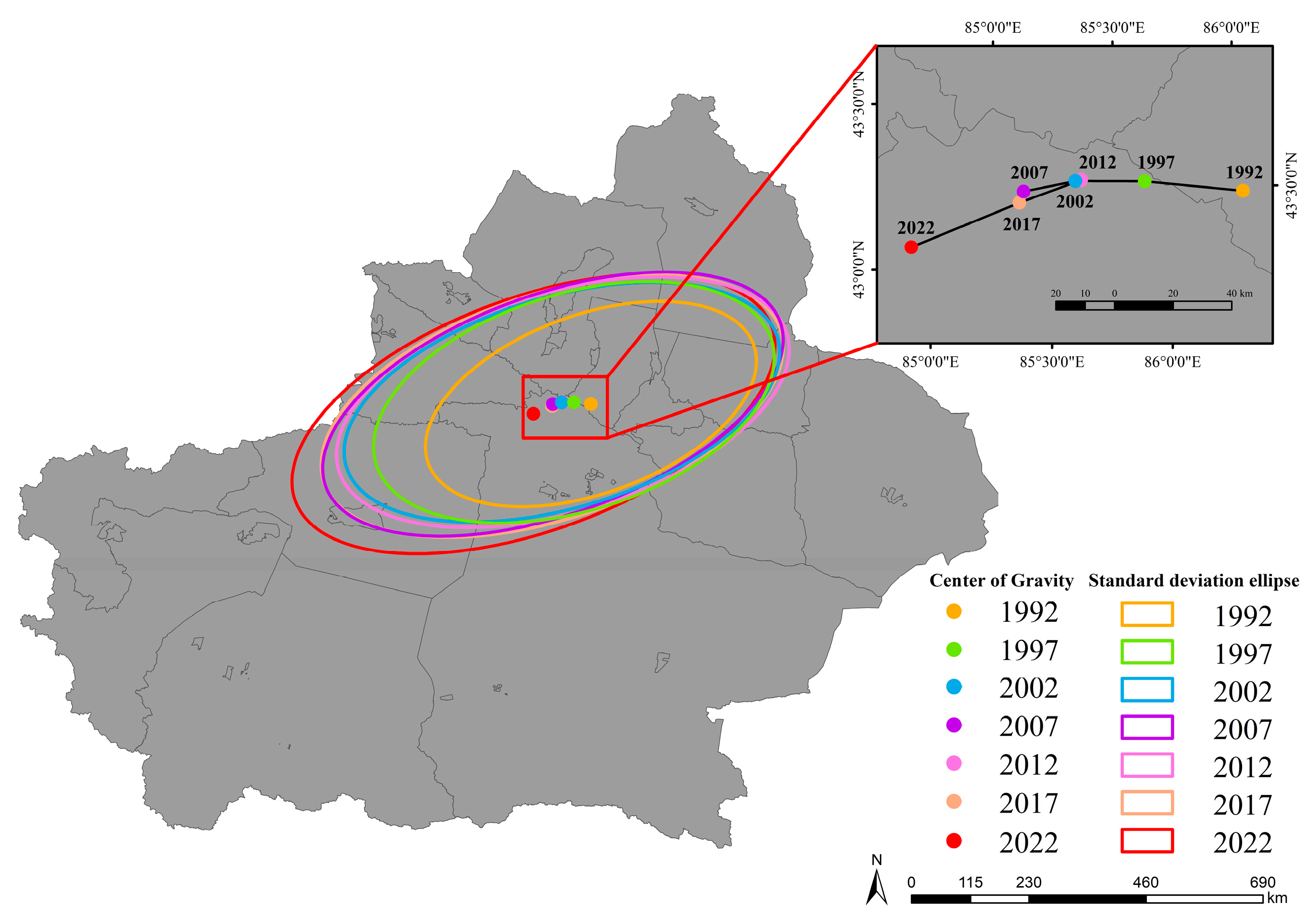
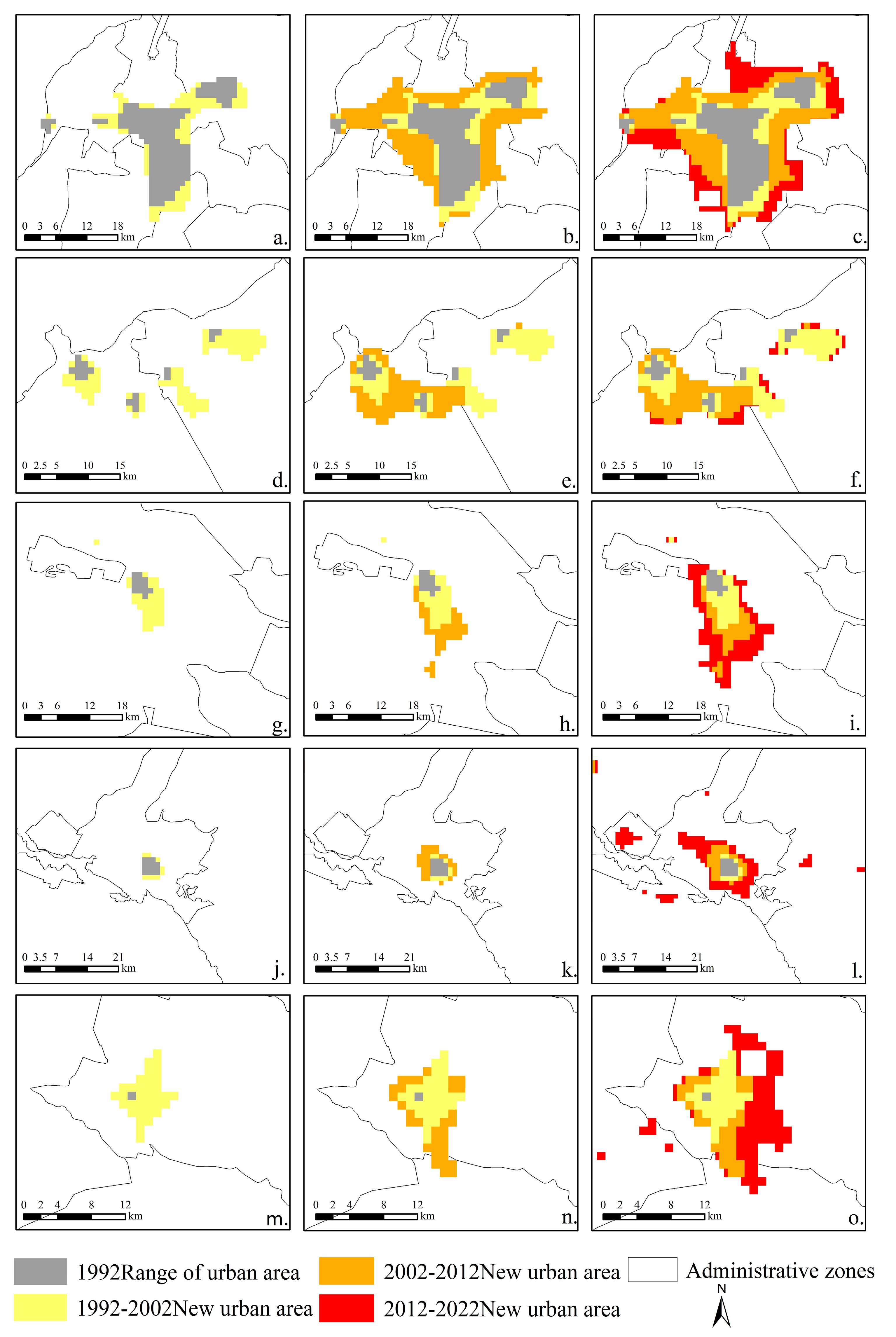

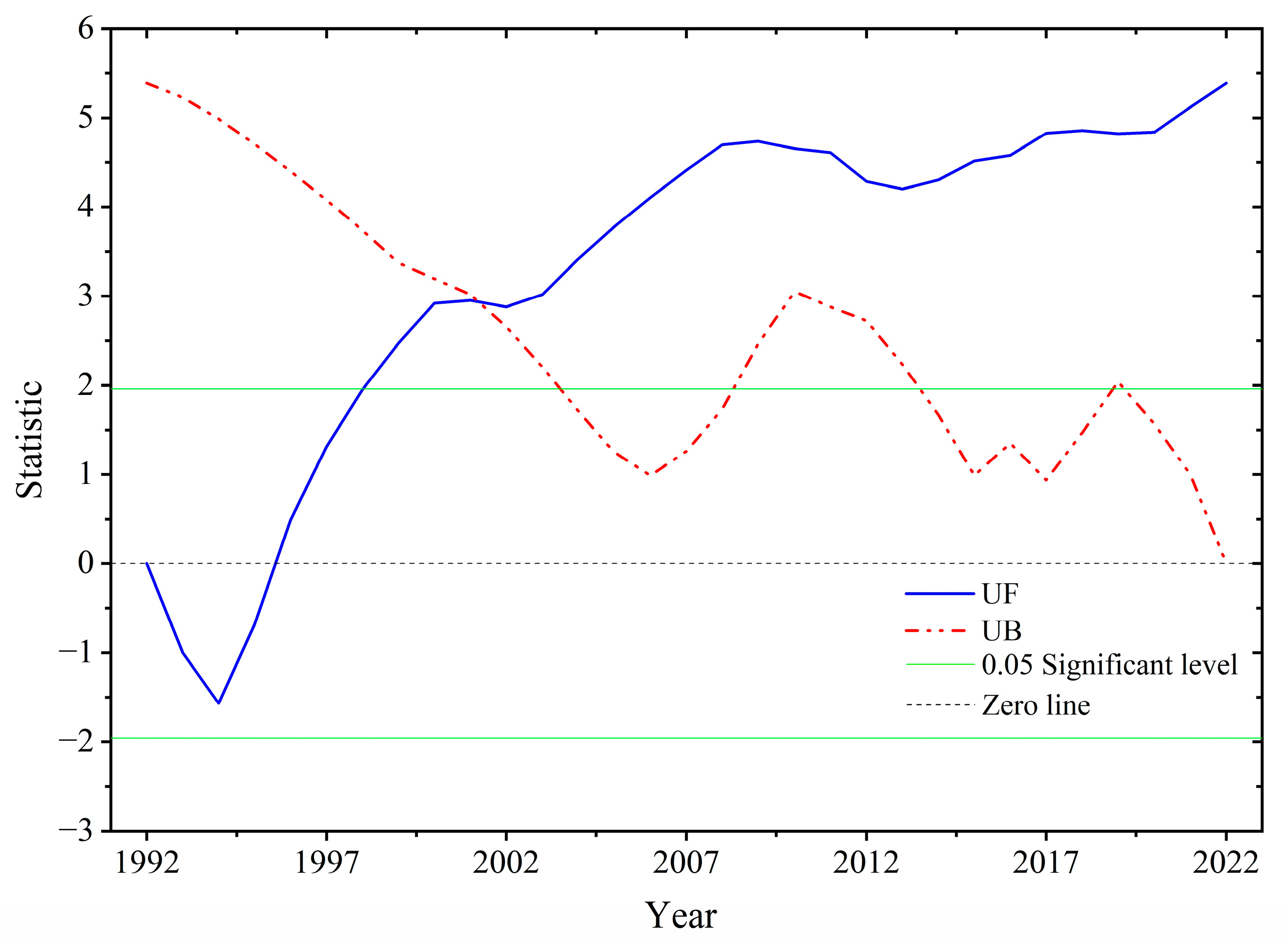

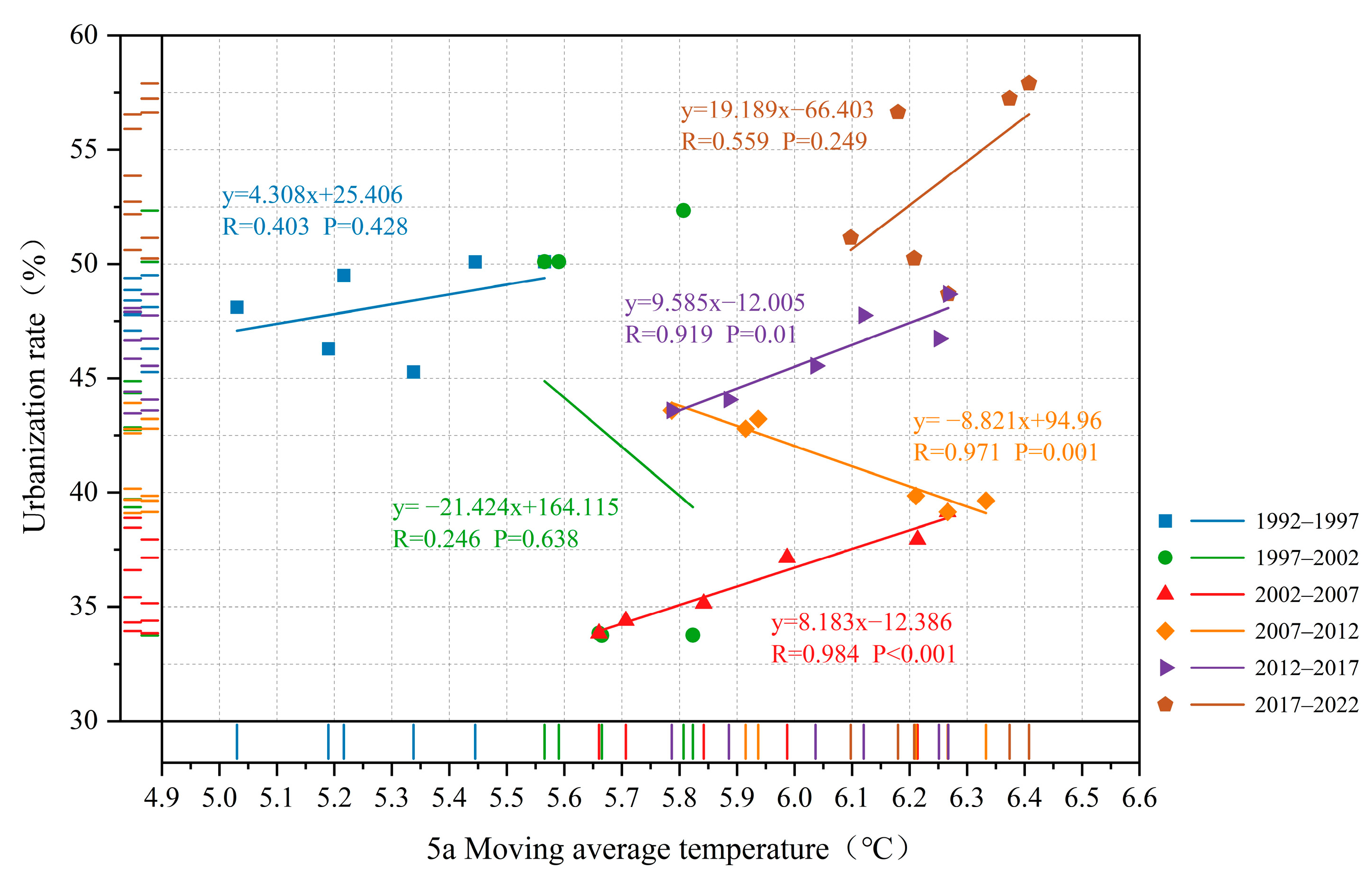
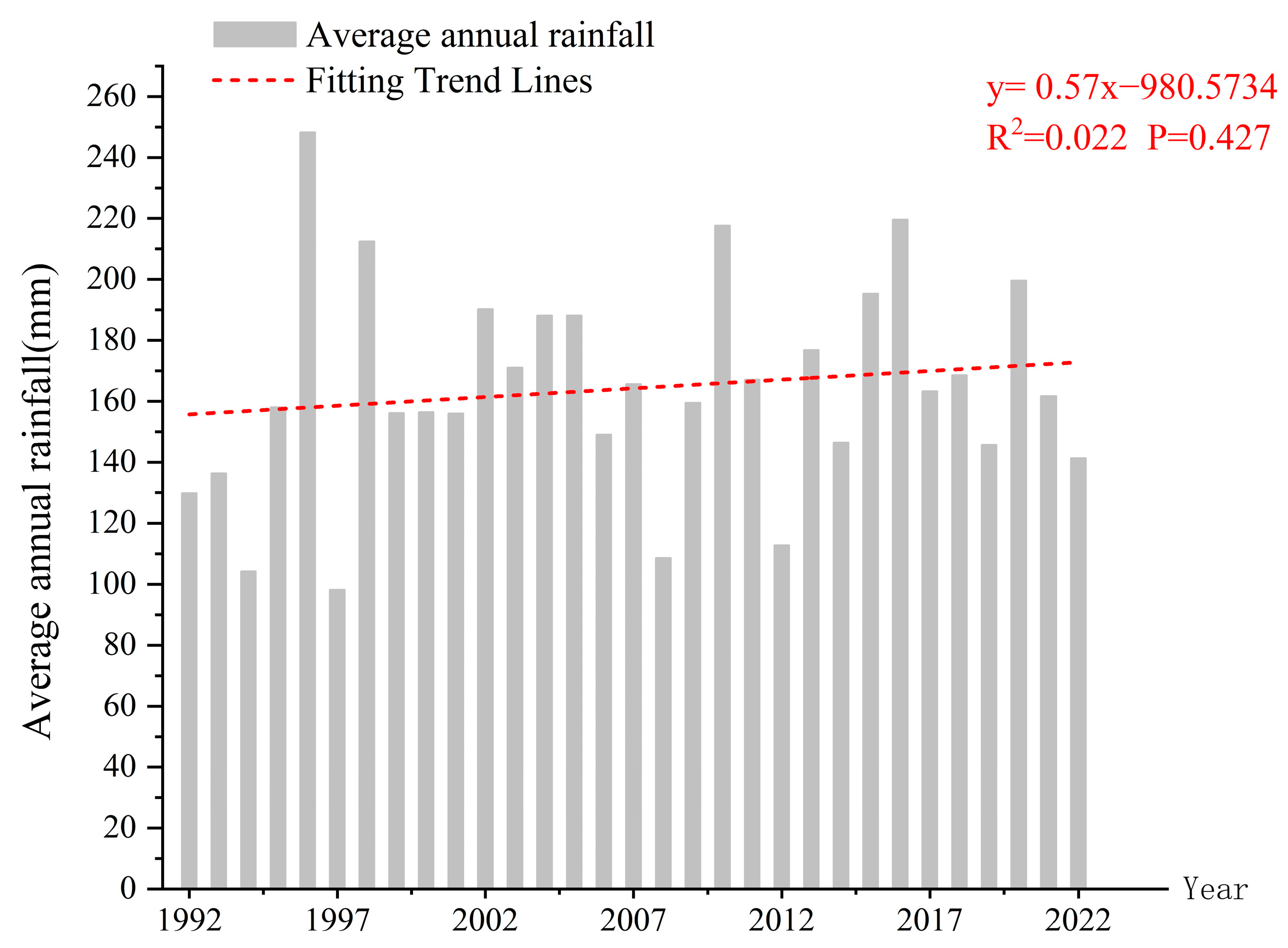
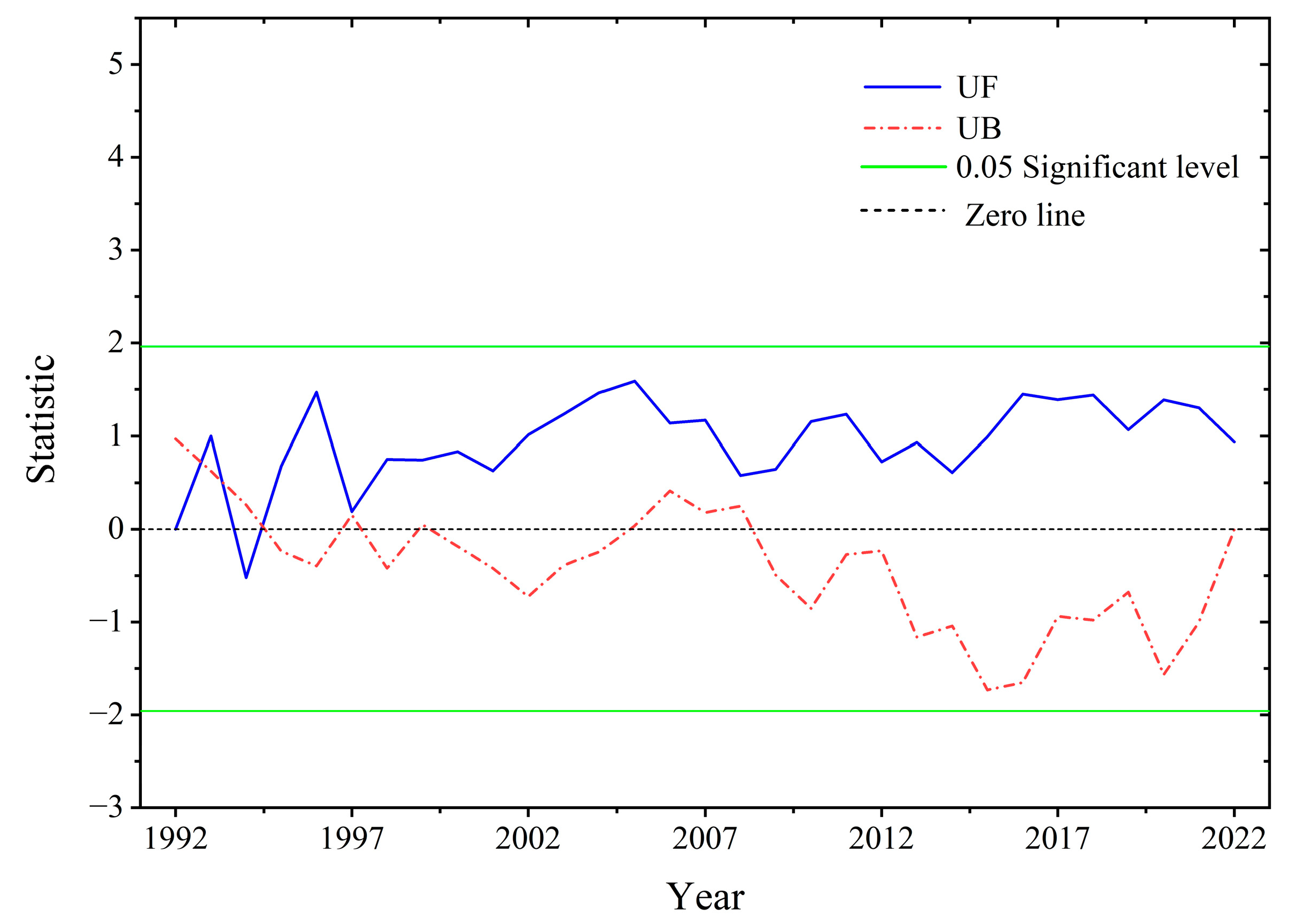
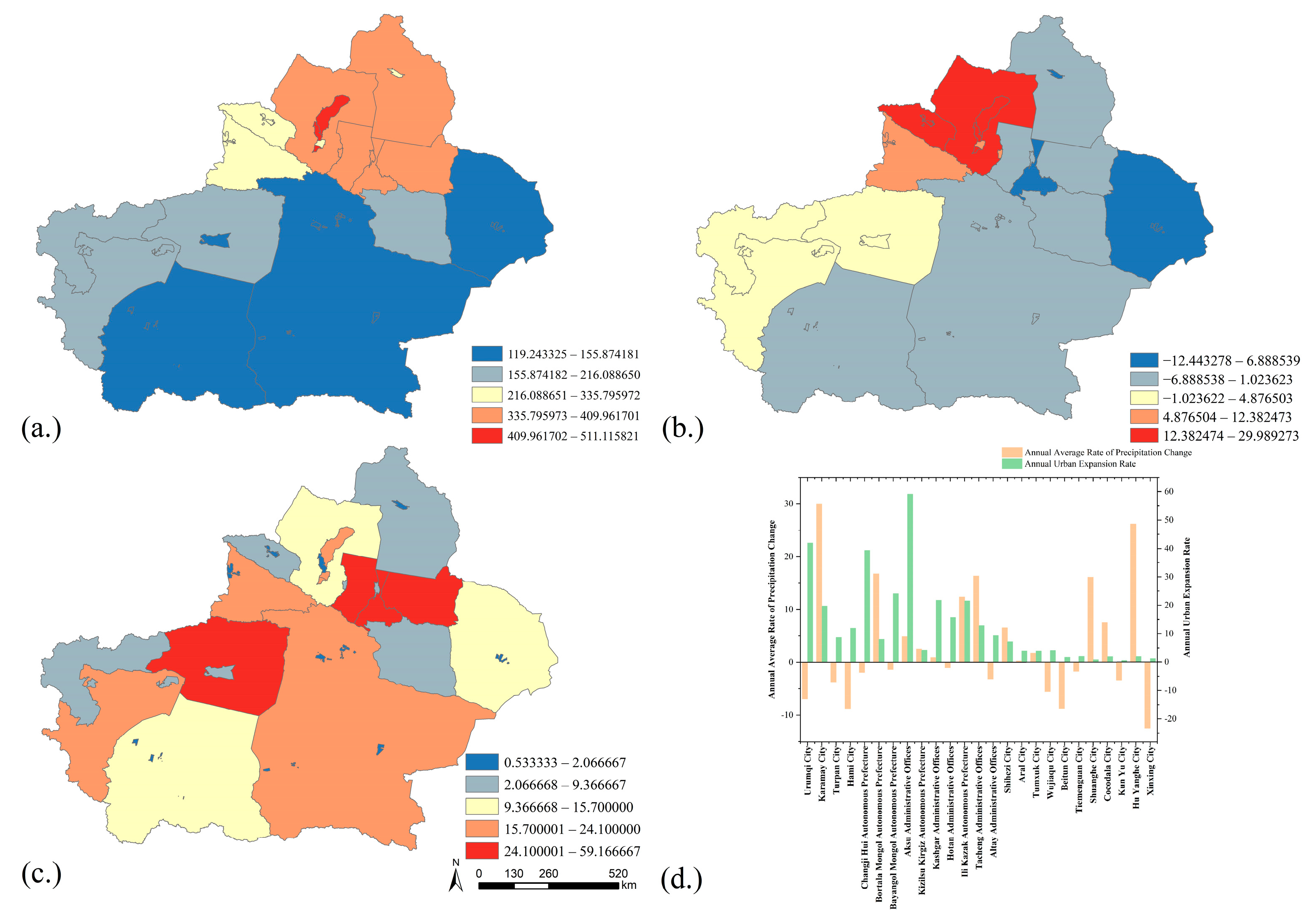


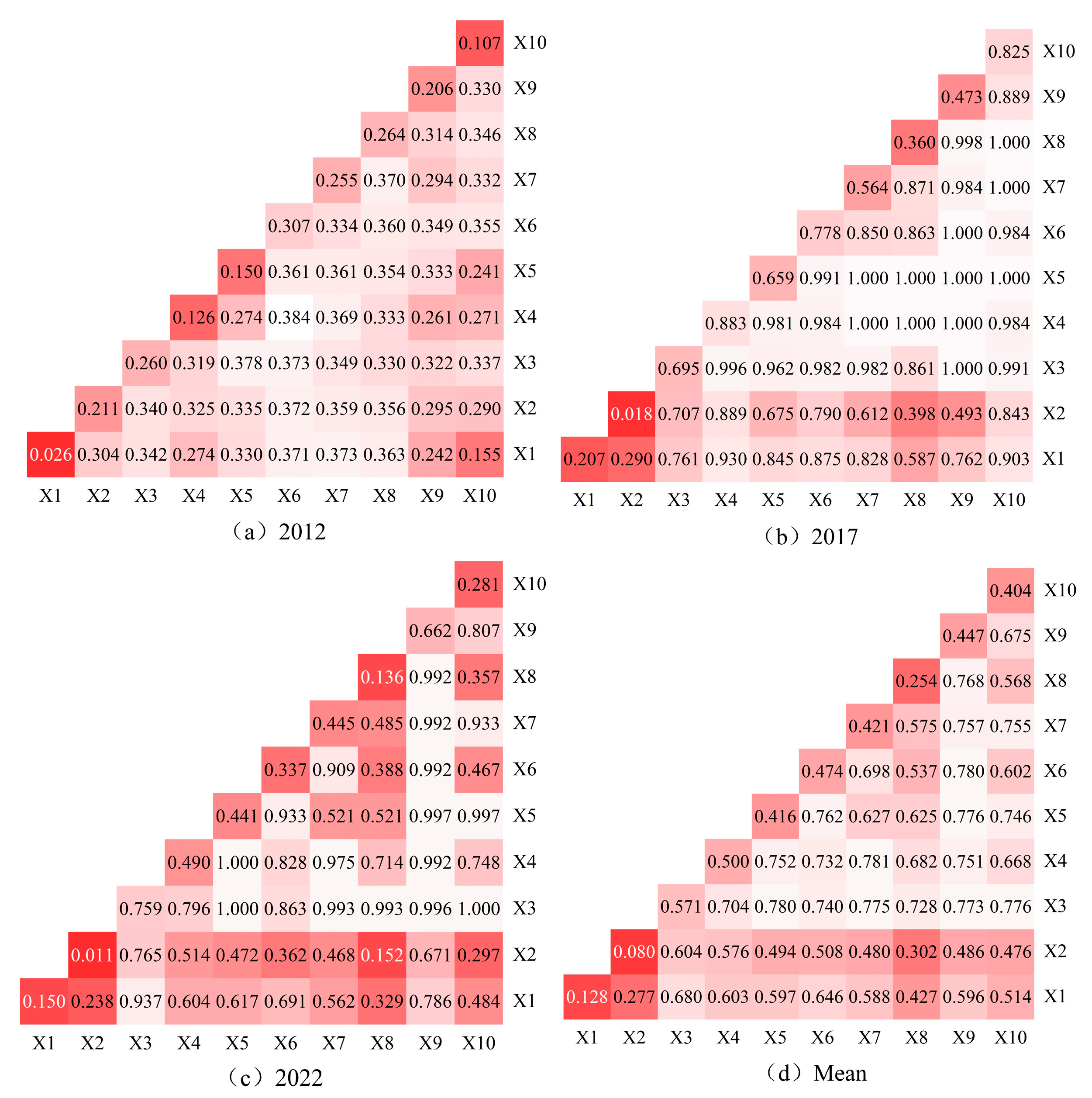
| Year | Circumference (km) | Area (km2) | Overall Accuracy (%) |
|---|---|---|---|
| 1992 | 375.17 | 368.61 | 83.21 |
| 1997 | 613.91 | 726.18 | 84.71 |
| 2002 | 792.02 | 898.01 | 80.74 |
| 2007 | 1050.00 | 1286.00 | 86.93 |
| 2012 | 1262.02 | 1692.00 | 81.38 |
| 2017 | 1746.01 | 2142.99 | 84.83 |
| 2022 | 3076.00 | 3723.00 | 85.40 |
| Year | Oblateness | Azimuth (°) | Center-of-Gravity Coordinates | Center-of-Gravity Traveled Distance (km) | Center-of-Gravity Shift Direction |
|---|---|---|---|---|---|
| 1992 | 0.487 | 70.106 | (86°10′01″ E, 43°27′59″ N) | ||
| 46.5433 | Northwest | ||||
| 1997 | 0.479 | 72.689 | (85°44′57″ E, 43°26′07″ N) | ||
| 32.4862 | Northwest | ||||
| 2002 | 0.533 | 73.523 | (85°27′35″ E, 43°23′37″ N) | ||
| 24.0594 | Southwest | ||||
| 2007 | 0.547 | 70.223 | (85°15′11″ E, 43°19′45″ N) | ||
| 26.7808 | Northeast | ||||
| 2012 | 0.534 | 73.152 | (85°28′60″ E, 43°24′02″ N) | ||
| 29.0383 | Southwest | ||||
| 2017 | 0.535 | 71.622 | (85°14′43″ E, 43°17′34″ N) | ||
| 50.5630 | Southwest | ||||
| 2022 | 0.542 | 70.030 | (84°50′16″ E, 43°05′25″ N) |
Disclaimer/Publisher’s Note: The statements, opinions and data contained in all publications are solely those of the individual author(s) and contributor(s) and not of MDPI and/or the editor(s). MDPI and/or the editor(s) disclaim responsibility for any injury to people or property resulting from any ideas, methods, instructions or products referred to in the content. |
© 2024 by the authors. Licensee MDPI, Basel, Switzerland. This article is an open access article distributed under the terms and conditions of the Creative Commons Attribution (CC BY) license (https://creativecommons.org/licenses/by/4.0/).
Share and Cite
Wang, L.; Xu, W.; Xue, X.; Wang, H.; Li, Z.; Wang, Y. Analysis of Spatial and Temporal Changes and Drivers of Urban Sprawl in Xinjiang Based on Integrated DMSP-OLS and NPP-VIIRS Data. Land 2024, 13, 567. https://doi.org/10.3390/land13050567
Wang L, Xu W, Xue X, Wang H, Li Z, Wang Y. Analysis of Spatial and Temporal Changes and Drivers of Urban Sprawl in Xinjiang Based on Integrated DMSP-OLS and NPP-VIIRS Data. Land. 2024; 13(5):567. https://doi.org/10.3390/land13050567
Chicago/Turabian StyleWang, Luwei, Wenzhe Xu, Xuan Xue, Haowei Wang, Zhi Li, and Yang Wang. 2024. "Analysis of Spatial and Temporal Changes and Drivers of Urban Sprawl in Xinjiang Based on Integrated DMSP-OLS and NPP-VIIRS Data" Land 13, no. 5: 567. https://doi.org/10.3390/land13050567
APA StyleWang, L., Xu, W., Xue, X., Wang, H., Li, Z., & Wang, Y. (2024). Analysis of Spatial and Temporal Changes and Drivers of Urban Sprawl in Xinjiang Based on Integrated DMSP-OLS and NPP-VIIRS Data. Land, 13(5), 567. https://doi.org/10.3390/land13050567






